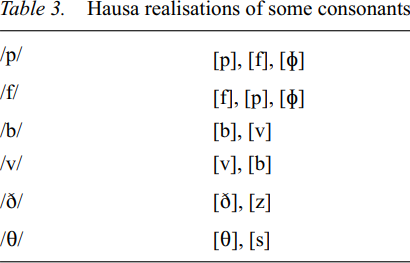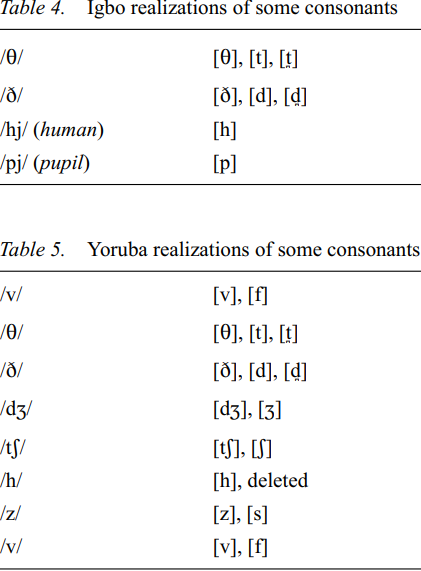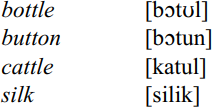


 Grammar
Grammar
 Tenses
Tenses
 Present
Present
 Past
Past
 Future
Future
 Parts Of Speech
Parts Of Speech
 Nouns
Nouns
 Verbs
Verbs
 Adverbs
Adverbs
 Adjectives
Adjectives
 Pronouns
Pronouns
 Pre Position
Pre Position
 Preposition by function
Preposition by function 
 Preposition by construction
Preposition by construction
 Conjunctions
Conjunctions
 Interjections
Interjections
 Grammar Rules
Grammar Rules
 Linguistics
Linguistics
 Semantics
Semantics
 Pragmatics
Pragmatics
 Reading Comprehension
Reading Comprehension|
Read More
Date: 2024-02-09
Date: 2024-06-28
Date: 2023-06-27
|
NigE is non-rhotic. The consonant system of NigE shows a lack of the postalveolar fricative /Ʒ/ and the velar nasal /ŋ/, which only exist in the speech of very sophisticated speakers with speech training (Jibril 1986). The consonant phonemes vary in their realizations between Hausa English, Yoruba English and Igbo English as illustrated in Tables 3 to 5 (cf. Jibril 1986; Jowitt 1991).


One general feature of NigE is the (probable) spelling pronunciation of many words. This applies to words ending in orthographic -mb, -ng and those with –st and –bt as in

and also (possibly) to a number of loan words such as

Equally, since orthography suggests it, final –ed is often realized as [d] as for example in increased. This in turn will trigger prevoicing of the consonant preceding the –ed so that the pronunciation is [inkrizd]. Voicing of [ks] can be observed in maximum [magzimçm] and laxity [lagziti], which has been described as an influence from American English (Görlach [1997]).
On the other hand, devoicing of final consonants is common in NigE (Simo Bobda 1997), as for example in with, which is often realized as [wiθ], robe, which is realized as [rop] and leave, which is realized as [lif]. Similarily, the plural /–z/ and third person singular /-z/ is often replaced by [-s] as in roads [rɔds] , doors [dɔs] and digs [dɪgs] (Jibril [1986]).
There are two simplification strategies for consonant clusters in NigE. One is the reduction of word-final consonant clusters by deletion of the last part as in

The consonant cluster /kw/ is reduced to [k] as in [εkɪpmεn(t)] for equipment. Quantitative support for this comes from an experimental study involving ‘reading passage’ style (Gut 2003). I found that syllable structures that never occur in NigE speech compared to British English speech are syllables with deleted vowels (C, CC, CCC), syllables with three consonants in the onset position (CCCV, CCCVC, CCCVVC), the syllable type VVC and syllables with three consonants in the coda position (CVCCC). Furthermore, Nigerians produce significantly more open syllables (syllables without a final consonant) than British English speakers reading the same passage, which reflects the high proportion of consonant deletions.
The other consonant cluster simplification strategy is the insertion of the epenthetic vowel [u] or [i] between word-final syllabic consonants and the preceding consonant as e.g. in

Epenthetic vowels are especially common in Hausa English.
Other phonological processes occurring in NigE include metathesis as in the pronunciation [aks] for ask and, especially in Hausa English, a tendency to gemination as in [gΛmmənt] for government (Jowitt 1991).
|
|
|
|
التوتر والسرطان.. علماء يحذرون من "صلة خطيرة"
|
|
|
|
|
|
|
مرآة السيارة: مدى دقة عكسها للصورة الصحيحة
|
|
|
|
|
|
|
نحو شراكة وطنية متكاملة.. الأمين العام للعتبة الحسينية يبحث مع وكيل وزارة الخارجية آفاق التعاون المؤسسي
|
|
|